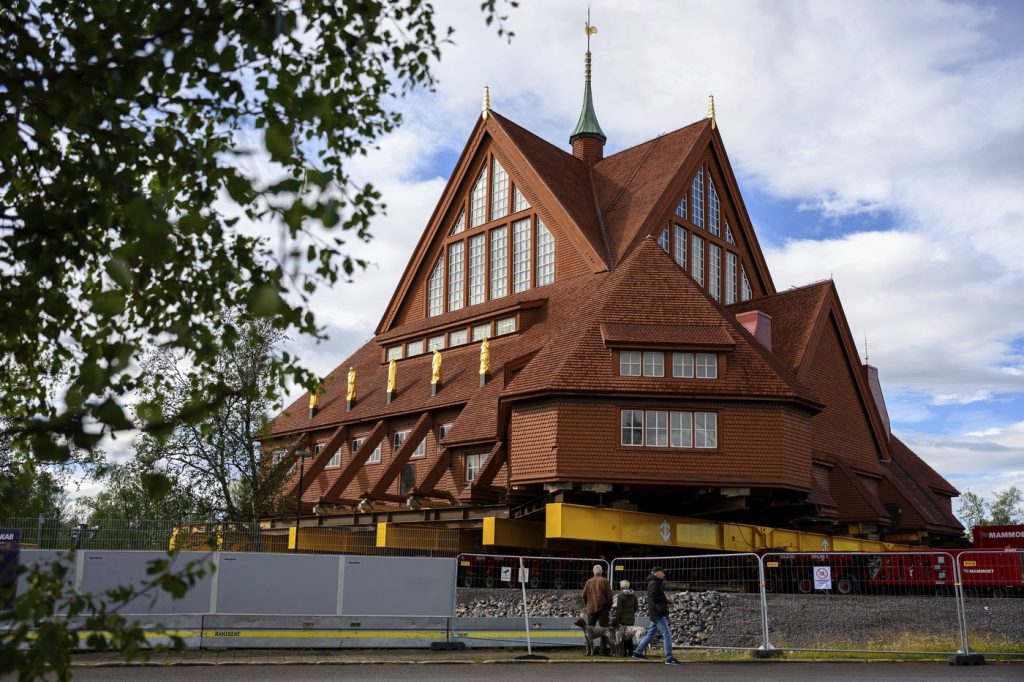KIRUNA, Sweden (AP) – Moving one of Sweden's most cherished wooden churches is no small feat. The Kiruna Church, or Kiruna Kyrka in Swedish, along with its belfry, is undergoing a significant relocation this week. The church will be transported along a 5-kilometer (3-mile) route east to a new city center as part of Kiruna's relocation initiative, necessitated by the mining activities of the world’s largest underground iron-ore mine that are threatening to engulf the town.
Located 200 kilometers (124 miles) above the Arctic Circle, Kiruna is Sweden's northernmost town, home to approximately 23,000 residents, including members of the Indigenous Sami community, spread over nearly 19,500 square kilometers (7,528 square miles). The move has attracted thousands of visitors eager to witness this historical event. Lena Tjärnberg, the church’s vicar, is set to commence the relocation with a blessing on Tuesday morning, with the move expected to conclude by Wednesday afternoon.
The church holds a special place in Swedish culture, having been voted the "best building of all time, built before 1950" in a Ministry of Culture poll in 2001. Constructed in 1912, the neo-Gothic church was designed in a style that reflects Sami architectural influence and was gifted by LKAB, the state-owned mining company. The Kiruna mine has been operational since 1910, and the church is widely recognized as the town’s most iconic structure, drawing tourists from far and wide until its closure last year in preparation for this move. The newly relocated church is scheduled to reopen at its new site in late 2026.
Reflecting on the church’s final service in its original location, Tjärnberg expressed a mix of emotions. “The last day you go down the stairs and close the church door, you know it’s going to be several years before you can open it – and in a new place,” she noted, pondering how it would feel to open the church doors again in the future.
This week’s move has transformed into a highly choreographed media spectacle orchestrated by LKAB, featuring appearances by notable figures, including King Carl XVI Gustaf. Musical performances are part of the celebration, including a set from KAJ, Sweden's 2025 Eurovision entry. SVT, Sweden’s national broadcaster, is livestreaming this unique move, branding it “The Great Church Walk,” building on the success of their previous "Great Moose Migration" broadcasts.
Kiruna's stunning landscape, famous for the Midnight Sun and the Northern Lights, attracts tourists year-round, with local highlights including the Aurora Sky Station, the Icehotel, and Kebnekaise, the highest mountain in Sweden. British tourists Anita and Don Haymes, who have visited Kiruna twice before, made special arrangements to witness the church's move, taking photographs of the structure before its relocation.
However, not everyone is pleased with LKAB’s lavish celebration. Lars-Marcus Kuhmunen, chairman of a Sami reindeer herding organization, expressed concerns that further mining activities by LKAB could threaten reindeer migration routes and endanger local livelihoods.
The planning for the relocation of Kiruna’s town center, which includes the church, dates back to 2004 as geological shifts and developments in the mine led to visible damage in buildings and roads. In order to reach a new depth of 1,365 meters (4,478 feet) and ensure the town’s safety, officials began moving buildings to a new downtown area located a safe distance away from the mine. Up until now, 25 buildings have been successfully relocated, with 16 remaining, including the church.
The church, weighing 672 metric tons (741 tons) and measuring approximately 40 meters (131 feet) wide, required special preparations for its move. Engineers expanded a crucial roadway from 9 meters to 24 meters (30 to 79 feet) and dismantled a viaduct to facilitate the transition. The relocation will take about 12 hours over two days, with scheduled breaks for fika, Sweden’s traditional afternoon coffee. The speed of the church's journey is expected to fluctuate between 0.5 and 1.5 kilometers per hour (0.31 and 0.93 miles per hour). Project manager Stefan Holmblad Johansson from LKAB declined to disclose the overall cost of the operation.










